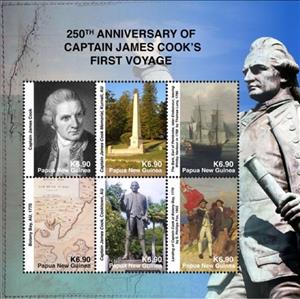Mini Sheet: 250th Anniversary of Capt. Cook's First Voyage (1) (Papua New Guinea 2018)
250th Anniversary of Capt. Cook's First Voyage (1) (Papua New Guinea 2018)
15 February (Papua New Guinea ) within release 250th Anniversary of Capt. Cook's First Voyage goes into circulation Mini Sheet 250th Anniversary of Capt. Cook's First Voyage (1) face value 41.40 Papua New Guinean kina
| Mini Sheet 250th Anniversary of Capt. Cook's First Voyage (1) in catalogues | |
|---|---|
| Colnect codes: | Col: PG 2018-01MS |
Mini Sheet is square format.
Contains the following 6 stamps : 6k.90 - Captain James Cook 6k.90 - Captain Cook memorial, Kurnelt, Australia 6k.90 - "The Bark Earl of Pembroke" (Thomas Luny, 1790) 6k.90 - Botany Bay, Australia, 1770 6k.90 - Captain Cook statue, Cookstown, Australia 6k.90 - "Landing of Captain cook at Botany Bay" (E. Phillips Fox, 1902)Also in the issue 250th Anniversary of Capt. Cook's First Voyage:
- Mini Sheet - 250th Anniversary of Capt. Cook's First Voyage (1) face value 41.40;
- Souvenir Sheet - 250th Anniversary of Capt. Cook's First Voyage (2) face value 20;
Mini Sheet 250th Anniversary of Capt. Cook's First Voyage (1) it reflects the thematic directions:
Exploration is the process of exploring, an activity which has some expectation of discovery. Organised exploration is largely a human activity, but exploratory activity is common to most organisms capable of directed locomotion and the ability to learn, and has been described in, amongst others, social insects foraging behaviour, where feedback from returning individuals affects the activity of other members of the group
A map is a symbolic depiction emphasizing relationships between elements of some space, such as objects, regions, or themes. Many maps are static, fixed to paper or some other durable medium, while others are dynamic or interactive. Although most commonly used to depict geography, maps may represent any space, real or imagined, without regard to context or scale, such as in brain mapping, DNA mapping, or computer network topology mapping. The space being mapped may be two dimensional, such as the surface of the earth, three dimensional, such as the interior of the earth, or even more abstract spaces of any dimension, such as arise in modeling phenomena having many independent variables. Although the earliest maps known are of the heavens, geographic maps of territory have a very long tradition and exist from ancient times. The word "map" comes from the medieval Latin Mappa mundi, wherein mappa meant napkin or cloth and mundi the world. Thus, "map" became the shortened term referring to a two-dimensional representation of the surface of the world.
A monument is a type of structure that was explicitly created to commemorate a person or event, or which has become relevant to a social group as a part of their remembrance of historic times or cultural heritage, due to its artistic, historical, political, technical or architectural importance. Examples of monuments include statues, (war) memorials, historical buildings, archaeological sites, and cultural assets. If there is a public interest in its preservation, a monument can for example be listed as a UNESCO World Heritage Site. The Palgrave Encyclopedia of Cultural Heritage and Conflict gives the next definition of monument:
A modern sailing ship or sailship is any large wind-powered vessel. Traditionally a sailing ship (or simply ship) is a sailing vessel that carries three or more masts with square sails on each. Large sailing vessels that are not ship-rigged may be more precisely referred to by their sail rig, such as schooner, barque (also spelled "bark"), brig, barkentine, brigantine or sloop. There are many different types of sailing ships, but they all have certain basic things in common. Every sailing ship has a hull, rigging and at least one mast to hold up the sails that use the wind to power the ship. The crew who sail a ship are called sailors or hands. They take turns to take the watch, the active managers of the ship and her performance for a period. Watches are traditionally four hours long. Some sailing ships use traditional ship's bells to tell the time and regulate the watch system, with the bell being rung once for every half hour into the watch and rung eight times at watch end (a four-hour watch). Ocean journeys by sailing ship can take many months, and a common hazard is becoming becalmed because of lack of wind, or being blown off course by severe storms or winds that do not allow progress in the desired direction. A severe storm could lead to shipwreck, and the loss of all hands. Sailing ships are limited in their maximum size compared to ships with heat engines, so economies of scale are also limited. The heaviest sailing ships (limited to those vessels for which sails were the primary means of propulsion) never exceeded 14,000 tons displacement. Sailing ships are therefore also very limited in the supply capacity of their holds, so they have to plan long voyages carefully to include many stops to take on provisions and, in the days before watermakers, fresh water.




